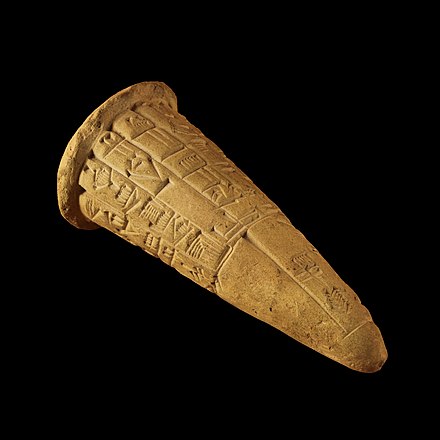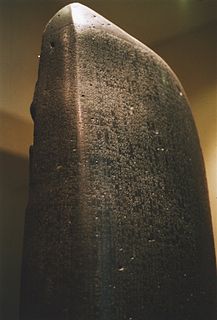
The Code of Hammurabi is a well-preserved Babylonian code of law of ancient Mesopotamia, dated to about 1754 BC. It is one of the oldest deciphered writings of significant length in the world. The sixth Babylonian king, Hammurabi, enacted the code. A partial copy exists on a 2.25-metre-tall (7.5 ft) stone stele. It consists of 282 laws, with scaled punishments, adjusting "an eye for an eye, a tooth for a tooth" as graded based on social stratification depending on social status and gender, of slave versus free, man versus woman.

Hammurabi was the sixth king of the First Babylonian dynasty of the Amorite tribe, reigning from c. 1792 BC to c. 1750 BC. He was preceded by his father, Sin-Muballit, who abdicated due to failing health. During his reign, he conquered Elam and the city-states of Larsa, Eshnunna, and Mari. He ousted Ishme-Dagan I, the king of Assyria, and forced his son Mut-Ashkur to pay tribute, bringing almost all of Mesopotamia under Babylonian rule.

Sumer is the earliest known civilization in the historical region of southern Mesopotamia, emerging during the Chalcolithic and early Bronze Ages between the sixth and fifth millennium BC. It is also one of the first civilizations in the world, along with Ancient Egypt, Norte Chico, Minoan civilization, Ancient China and the Indus Valley. Living along the valleys of the Tigris and Euphrates, Sumerian farmers grew an abundance of grain and other crops, the surplus from which enabled them to form urban settlements. Prehistoric proto-writing dates back before 3000 BC. The earliest texts come from the cities of Uruk and Jemdet Nasr, and date to between c. 3500 and c. 3000 BC.

The Sumerian King List is an ancient text in the Sumerian language, listing kings of Sumer from Sumerian and neighboring dynasties, their supposed reign lengths, and the locations of the kingship. This text is preserved in several recensions. The list of kings is sequential, although modern research indicates many were contemporaries, reflecting the belief that kingship was handed down by the gods and could be transferred from one city to another, asserting to a hegemony in the region.

Uruk was an ancient city of Sumer situated east of the present bed of the Euphrates River on the dried-up ancient channel of the Euphrates 30 km (19 mi) east of modern Samawah, Al-Muthannā, Iraq.
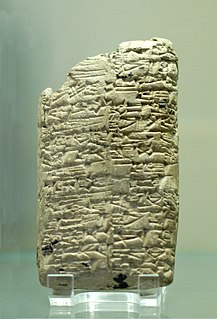
In the Ancient Near East, clay tablets were used as a writing medium, especially for writing in cuneiform, throughout the Bronze Age and well into the Iron Age.

Cuneiform was one of the earliest systems of writing, invented by Sumerians in ancient Mesopotamia. It is distinguished by its wedge-shaped marks on clay tablets, made by means of a blunt reed for a stylus. The term cuneiform comes from cuneus, Latin for "wedge".

Adab or Udab was an ancient Sumerian city between Telloh and Nippur. It was located at the site of modern Bismaya or Bismya in the Wasit Province of Iraq.
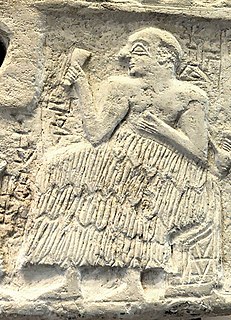
Ur-Nanshe also Ur-Nina, was the first king of the First Dynasty of Lagash in the Sumerian Early Dynastic Period III. He is known through inscriptions to have commissioned many buildings projects, including canals and temples, in the state of Lagash, and defending Lagash from its rival state Umma. He was probably not from royal lineage, being the son of Gunidu who was recorded without an accompanying royal title. He was the father of Akurgal, who succeeded him, and grandfather of Eanatum. Eanatum expanded the kingdom of Lagash by defeating Umma as illustrated in the Stele of the Vultures and continue building and renovation of Ur-Nanshe's original buildings.

Shulgi of Ur was the second king of the Third Dynasty of Ur during the Sumerian Renaissance. He reigned for 48 years, from c. 2094–c. 2047 BC or possibly c. 2029 – 1982 BC. His accomplishments include the completion of construction of the Great Ziggurat of Ur, begun by his father Ur-Nammu. On his inscriptions, he took the titles "King of Ur", "King of Sumer and Akkad" and "King of the four corners of the universe". He used the symbol for divinity before his name, marking his apotheosis, from the 23rd year of his reign.

Bad-tibira(Sumerian: 𒂦𒁾𒉄𒆠, bad3-tibiraki), "Wall of the Copper Worker(s)", or "Fortress of the Smiths", identified as modern Tell al-Madineh, between Ash Shatrah and Tell as-Senkereh in southern Iraq, was an ancient Sumerian city, which appears among antediluvian cities in the Sumerian King List. Its Akkadian name was Dûr-gurgurri. It was also called Παντιβίβλος (Pantibiblos) by Greek authors such as Berossus, transmitted by Abydenus and Apollodorus. This may reflect another version of the city's name, Patibira, "Canal of the Smiths".
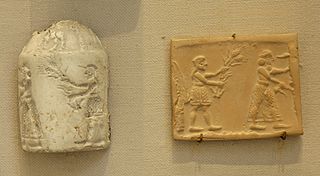
A cylinder seal is a small round cylinder, typically about one inch in length, engraved with written characters or figurative scenes or both, used in ancient times to roll an impression onto a two-dimensional surface, generally wet clay. According to some sources, cylinder seals were invented around 3500 BC in the Near East, at the contemporary sites of Uruk in southern Mesopotamia and slightly later at Susa in south-western Iran during the Proto-Elamite period, and they follow the development of stamp seals in the Halaf culture or slightly earlier. They are linked to the invention of the latter’s cuneiform writing on clay tablets. Other sources, however, date the earliest cylinder seals to a much earlier time, to the Late Neolithic period, hundreds of years before the invention of writing. (They were used as an administrative tool, a form of signature, as well as jewelry and as magical amulets; later versions would employ notations with Mesopotamian cuneiform. In later periods, they were used to notarize or attest to multiple impressions of clay documents. Graves and other sites housing precious items such as gold, silver, beads, and gemstones often included one or two cylinder seals, as honorific grave goods.

Entemena, also called Enmetena, flourished 2400 BC, was a son of En-anna-tum I, and he reestablished Lagash as a power in Sumer. He defeated Il, king of Umma in a territorial conflict, through an alliance with Lugal-kinishe-dudu of Uruk, successor to Enshakushanna, who is in the king list. The tutelary deity Shul-utula was his personal deity. His rule lasted 29 years.
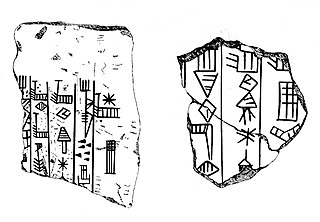
Enshakushanna, or Enshagsagana, En-shag-kush-ana, Enukduanna, En-Shakansha-Ana, was a king of Uruk around the mid-3rd millennium BC who is named on the Sumerian King List, which states his reign to have been 60 years. He conquered Hamazi, Akkad, Kish, and Nippur, claiming hegemony over all of Sumer.
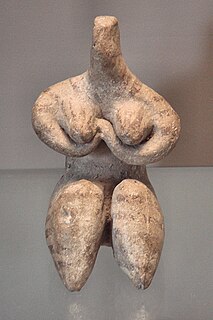
The art of Mesopotamia has survived in the archaeological record from early hunter-gatherer societies on to the Bronze Age cultures of the Sumerian, Akkadian, Babylonian and Assyrian empires. These empires were later replaced in the Iron Age by the Neo-Assyrian and Neo-Babylonian empires. Widely considered to be the cradle of civilization, Mesopotamia brought significant cultural developments, including the oldest examples of writing.
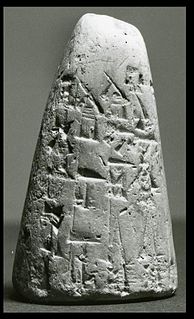
Sîn-kāšid was the king of the ancient Mesopotamian city of Uruk during the first half of the 18th century BC. His precise dating is uncertain, perhaps ca. 1803–1770 BC corresponding to ca.1865–1833 BC, but likely to have been fairly long due to the voluminous building inscriptions extant for which he is best known and contemporary with Nur-Adad of Larsa and Enlil-bāni of Isin. His apparent lack of relationship with any of the preceding rulers of Uruk and his omission of mentioning his father in any of his inscriptions has led to the belief that he was the founder of a dynasty. He participated in a diplomatic marriage with Šallurtum, the daughter of Sūmû-la-Il, the second king of the First Babylonian Dynasty, as her name and epithets appear in the seal impressions of three clay bullae recovered from the remains of his palace.

The Hurrian foundation pegs, also known as the Urkish lions, are twin copper foundation pegs each in the shape of a lion that probably came from the ancient city of Urkesh in Syria. The pegs were placed at the foundation of the temple of Nergal in the city of Urkesh as mentioned in the cuneiform inscriptions on them. The inscription on the two pegs and the associated stone tablet is the oldest known text in the Hurrian language. One of the lions is now housed, along with its limestone tablet, in the Musée du Louvre in Paris. The second lion is on display at the Metropolitan Museum of Art in New York.
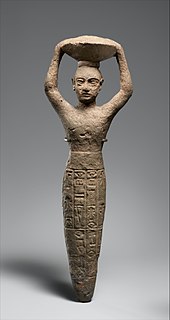
Foundation figures were ritualistic works of art from the Early Dynastic period that were used in the construction of ancient Mesopotamian temples. Foundation pegs first appeared in ancient Sumer around the third millennium BCE. Stylized as anthropomorphic nails, foundation figures were symbolically used to mark the grounds of a temple. These nails/pegs were either hammered around the foundation of the temple, along with an inscribed tablet, or they were buried in clay boxes under the foundation of the temple. Typically, the pegs were created to represent either the deity that the temple was honoring, or the king that orchestrated the construction of the temple. Many of the pegs discovered stand about a foot tall and show a clear attention to detail. It is believed that foundation figures were used for solely ritualistic purposes. This is because they were not meant to be seen by the public, yet still show a high level of detail and aesthetic thought.
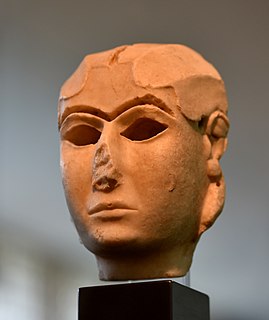
The art of Uruk encompasses the sculptures, seals, pottery, architecture, and other arts produced in Uruk, an ancient city in southern Mesopotamia that thrived during the Uruk period around 4200-3000 BCE. The city continued to develop into the Early Dynastic Period (Mesopotamia) around 2900-2350 BCE. Considered one of the first cities, the site of Uruk – modern-day Warka in Iraq – shows evidence of social stratification, institutionalized religion, a centralized administration, and what art historians would categorize as high art and architecture, the first in the long history of the art of Mesopotamia. Much of the art of Uruk shows a high technical skill and was often made using precious materials.

Lugal-kinishe-dudu also Lugal-kiginne-dudu , was a King and (ensi) of Uruk and Ur who lived towards the end of the 25th century BCE, succeeding his father Enshakushana, founder of the second dynasty of Uruk, according to the Sumerian King List. This last text mentions Lugal-kinishe-dudu as the second king of the dynasty after En-cakanca-ana, attributing him a fanciful reign of 120 years.

